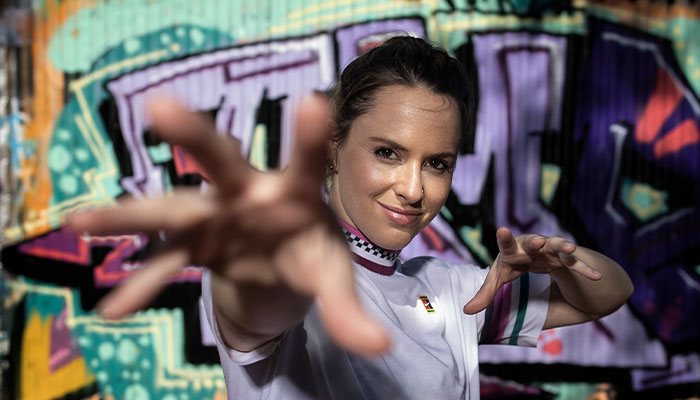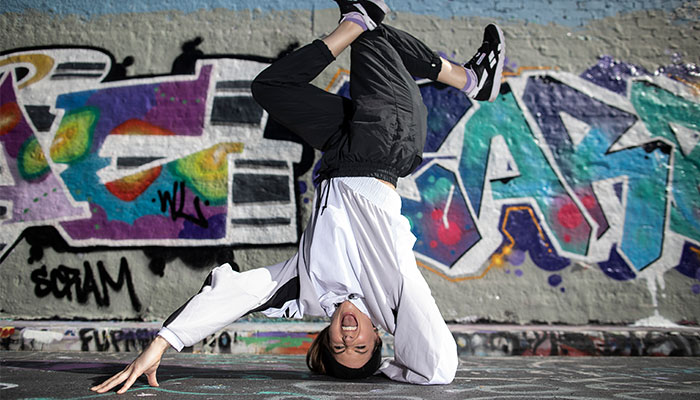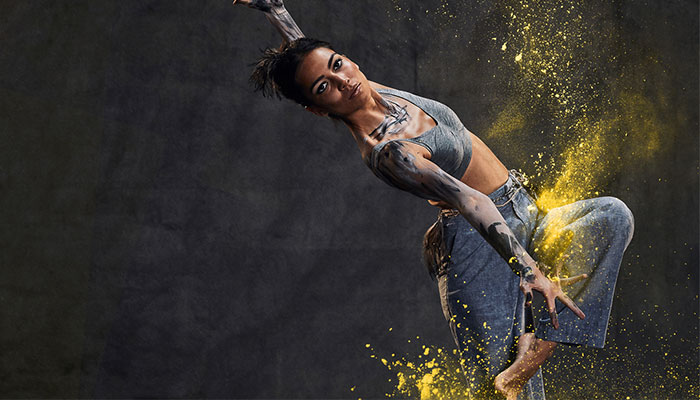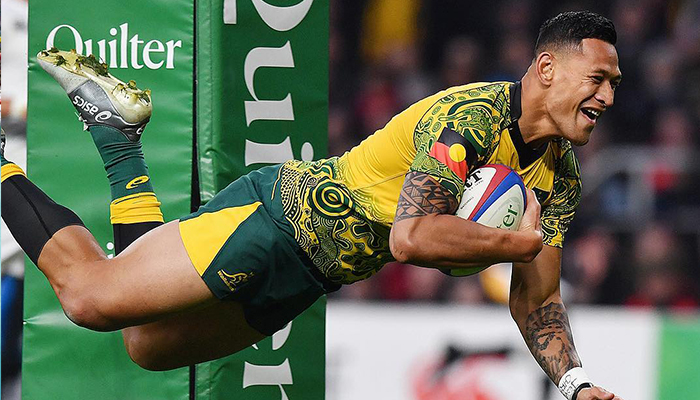Dr Rachael Gunn got introduced to breakdancing 12 years ago. She’s now Australia’s highest ranked woman in this athletic form of street dance.
WATCH: Dr Rachael Gunn, also known as b-girl Raygun, breaking in a recent competition.
With her sights set on the 2024 Olympics following the International Olympic Committee's decision this month to include it as an official sport, Gunn is also researching the role of gender in the sport and culture that prefers to be known as 'breaking'.
Gunn, 33, a Macquarie University lecturer in media and creative industries, had always been interested in dance. When she accompanied her boyfriend to his breaking training sessions and then competitions in 2008, she became more intrigued.
“I was blown away by the energy, the skill, the culture and the amazing music,” she says. “But it was really male-dominated back then and initially I didn’t see that there was a space for me.”
Everyone was jumping into the middle and jamming, and she was the only girl and she kept jumping in too.
As she immersed herself in the Australian breaking scene, Gunn was on the lookout for women role models. She remembers distinctly the first time she saw a woman in the centre of a breaking circle surrounded by men in 2011.
“Everyone was jumping into the middle and jamming, and she was the only girl and she kept jumping in too,” says Gunn. “That moment stood out for me, and I thought 'I can do this too'.”
The visibility of women taking part helps bring other women into the scene and changes people's assumptions about women’s capabilities, Gunn says. “It’s a theme that runs through my interviews and research.”
Until recently, although breaking was very multicultural, women breakers, known as 'b-girls', had a secondary role in the sport globally, and faced many challenges as they fought from within, she says.
Challenging assumptions
Many male participants, known as 'b-boys', said women didn’t have the physical ability and strength to do many of the athletic ‘power’ moves, which include flares (legs revolving around the body in a V) back spins, head and hand spins, handstands and acrobatic flips.

Role model: Dr Gunn after the International Olympic Committee's announcement ... she says women breakdancers have proved they can be just as athletic and technical as men.
B-girls have shown this was a total misconception, Gunn says. “As more women around the world participated in the activity they challenged the assumptions and showed they can do the power moves, and they can be just as athletic and technical.”
Also, a decade ago women with muscular bodies were not as accepted as they are today, she argues in her research. Many b-girls - including Gunn - faced derogatory comments and judgement. Other women in sport, such as tennis players, for example, also received criticism for having 'masculine bodies'.
- How critical can you be in online reviews without being sued for defamation?
- Why we need more brazen hussies in Australia today
Gunn says many of the breaking moves designed by men for men have now been altered and reimagined for women.
But the dance is changing and in the past six years, international b-girls such as Ayumi in Japan, Queen Mary in Bulgaria and AT in Finland have inspired Gunn and other women in Australia searching for female role models.
Gunn’s research also disputes some of the stereotypes of breaking – such as that breakers don’t have to be top athletes.
Strong foundations
She says that every b-girl or b-boy who succeeds needs to have musicality and originality, a strong foundation in dance moves, strength and stamina achieved through weight training and High Intensity Interval Training, as well as high cardiovascular fitness.

Head way: Dr Gunn (pictured) says gender equality has greatly improved since she started breakdancing.
Breakers also need mental agility because they don’t memorise routines like gymnasts, but draw upon a whole selection of moves that they combine in a spontaneous ad lib routine as they battle their opponent.
Breaking evolved in the early 1970s in New York City when DJs created loops, the 'breaks' between disco and funk numbers. Dancers mainly from African-American, Latino, and Caribbean heritage started creating moves that fit in these musical interludes and developed their own culture, fashion and terms to describe themselves and their moves. Competition was always part of the dance.
In the 1980s, breaking gained international prominence when Rock Steady Crew performed in Flashdance and other movies, as well as for Queen Elizabeth II and in the 1984 LA Olympics opening ceremony.
Now that it’s going to be an Olympic sport having men and women participate and dance together equally is a really positive outcome for everyone.
Breaking had its international test run at the 2018 Youth Olympics held in Buenos Aires, Argentina.
“It was so popular and had an overwhelming amount of spectators,” Gunn says. “We’re very excited as a breaking community, because it gives recognition to the dancers and will bring more opportunities to us – we anticipate more than 70 countries will participate.”
- Shark, grasshopper studies point to winners and losers of rising heat
- New COVID-19 strategy: vaccinate potential superspreaders first
Gender equality has really improved since she started breaking, she acknowledges. “Now that it’s going to be an Olympic sport having men and women participate and dance together equally is a really positive outcome for everyone.”
Gunn hopes to maintain her own number one b-girl status to be considered as one of the Australian representatives at the Games.
The breaking community welcomes anyone who wants to learn. Contact the Australian Breaking Association to find a workshop near you.
Dr Rachael Gunn is a lecturer and interdisciplinary researcher in the Department of Media, Music, Communication and Cultural Studies



